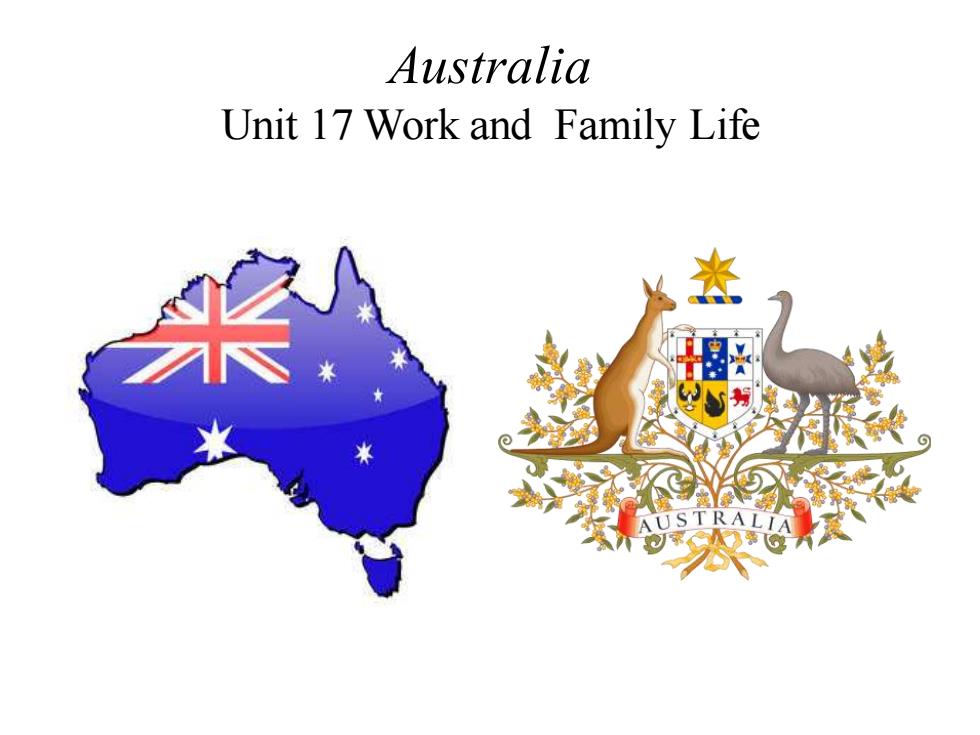
Australia Unit 17 Work and Family Life
Australia Unit 17 Work and Family Life

Quiz Give the English and a brief explanation for the following: 1罪犯流放地 2女子工 3新南威尔士 4酒馆老板 5金矿的发现
Quiz Give the English and a brief explanation for the following: 1 罪犯流放地 2 女子工厂 3 新南威尔士 4 酒馆老板 5 金矿的发现
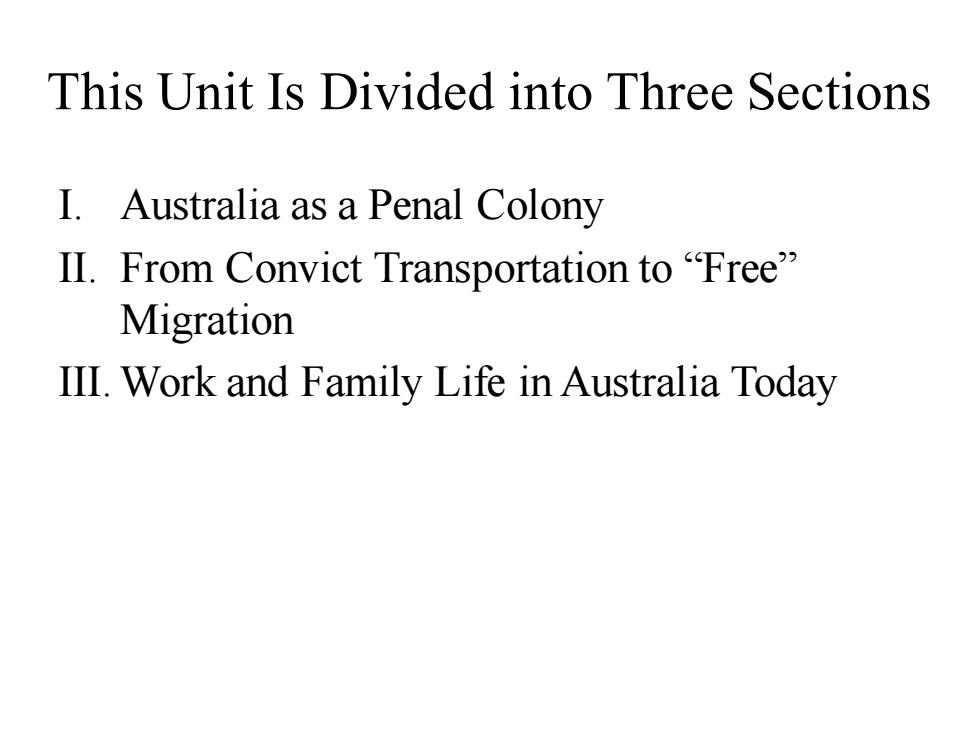
This Unit Is Divided into Three Sections I.Australia as a Penal Colony IⅡ.From Convict Transportation to“Free” Migration III.Work and Family Life in Australia Today
This Unit Is Divided into Three Sections I. Australia as a Penal Colony II. From Convict Transportation to “Free” Migration III. Work and Family Life in Australia Today
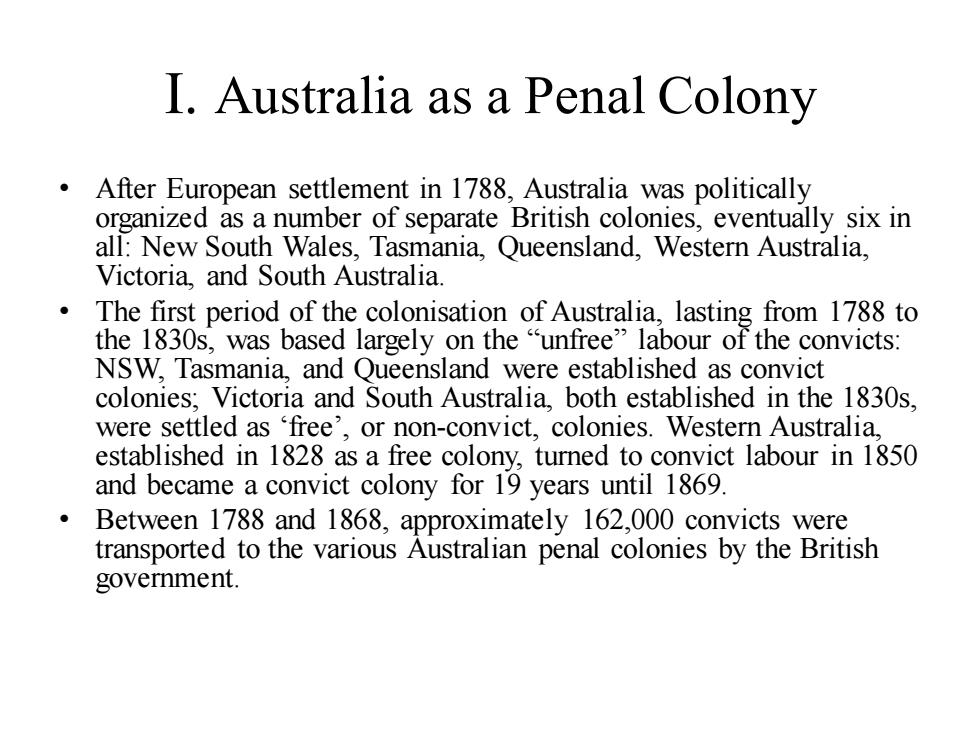
I.Australia as a Penal Colony After European settlement in 1788,Australia was politically organized as a number of separate British colonies,eventually six in all:New South Wales,Tasmania,Queensland,Western Australia, Victoria,and South Australia. The first period of the colonisation of Australia,lasting from 1788 to the 1830s,was based largely on the "unfree"labour of the convicts: NSW,Tasmania,and Queensland were established as convict colonies;Victoria and South Australia,both established in the 1830s, were settled as free',or non-convict,colonies.Western Australia, established in 1828 as a free colony,turned to convict labour in 1850 and became a convict colony for 19 years until 1869. Between 1788 and 1868,approximately 162,000 convicts were transported to the various Australian penal colonies by the British government
I. Australia as a Penal Colony • After European settlement in 1788, Australia was politically organized as a number of separate British colonies, eventually six in all: New South Wales, Tasmania, Queensland, Western Australia, Victoria, and South Australia. • The first period of the colonisation of Australia, lasting from 1788 to the 1830s, was based largely on the “unfree” labour of the convicts: NSW, Tasmania, and Queensland were established as convict colonies; Victoria and South Australia, both established in the 1830s, were settled as ‘free’, or non-convict, colonies. Western Australia, established in 1828 as a free colony, turned to convict labour in 1850 and became a convict colony for 19 years until 1869. • Between 1788 and 1868, approximately 162,000 convicts were transported to the various Australian penal colonies by the British government
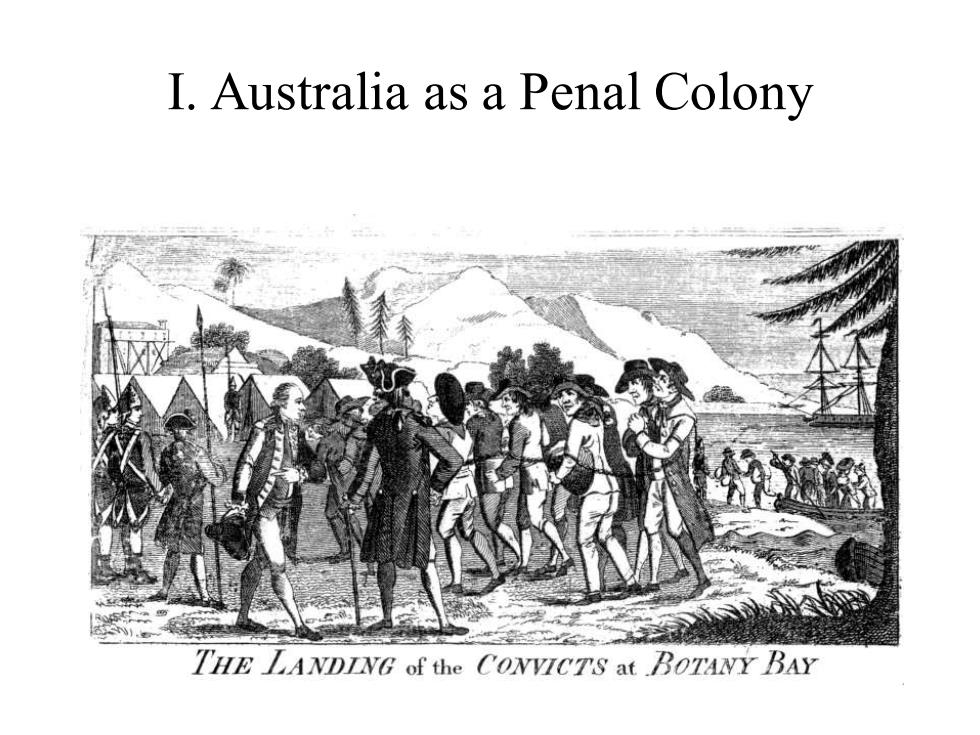
I.Australia as a Penal Colony THE LANDING of the CONVICTS at BOTANY BAY
I. Australia as a Penal Colony
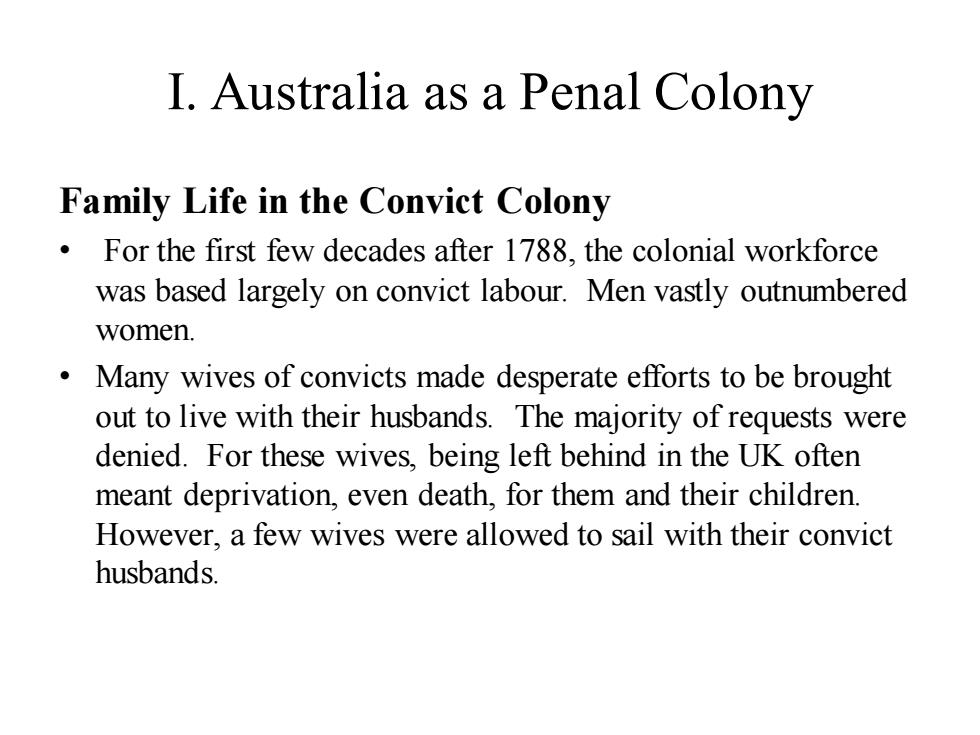
I.Australia as a Penal Colony Family Life in the Convict Colony For the first few decades after 1788,the colonial workforce was based largely on convict labour.Men vastly outnumbered women. Many wives of convicts made desperate efforts to be brought out to live with their husbands.The majority of requests were denied.For these wives,being left behind in the UK often meant deprivation,even death,for them and their children. However,a few wives were allowed to sail with their convict husbands
I. Australia as a Penal Colony Family Life in the Convict Colony • For the first few decades after 1788, the colonial workforce was based largely on convict labour. Men vastly outnumbered women. • Many wives of convicts made desperate efforts to be brought out to live with their husbands. The majority of requests were denied. For these wives, being left behind in the UK often meant deprivation, even death, for them and their children. However, a few wives were allowed to sail with their convict husbands
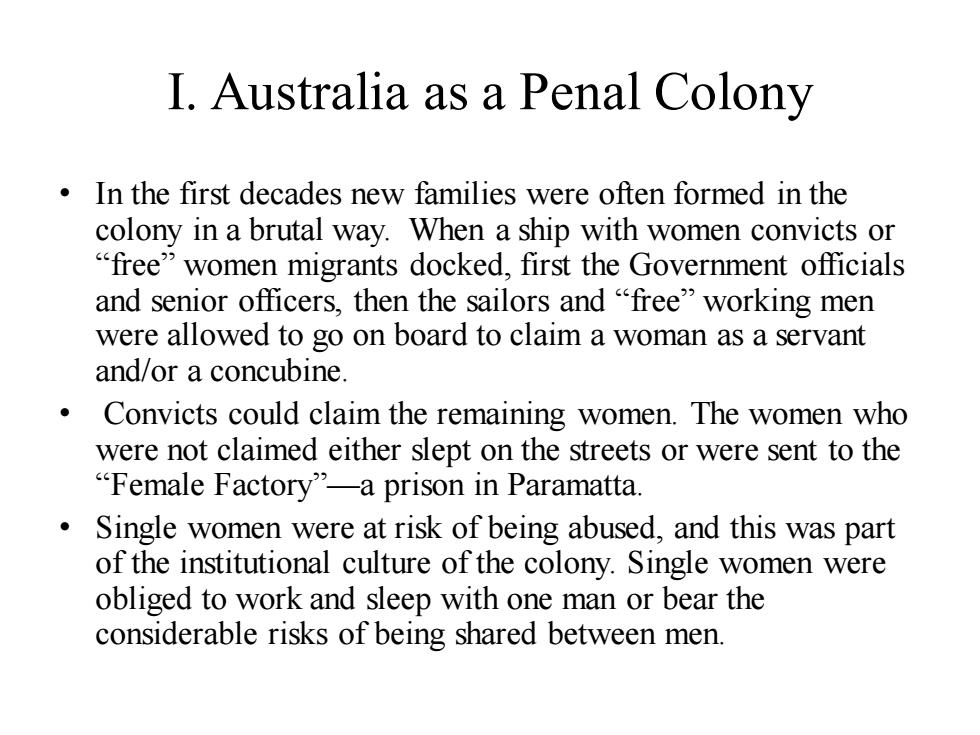
I.Australia as a Penal Colony In the first decades new families were often formed in the colony in a brutal way.When a ship with women convicts or "free"women migrants docked,first the Government officials and senior officers,then the sailors and "free"working men were allowed to go on board to claim a woman as a servant and/or a concubine. Convicts could claim the remaining women.The women who were not claimed either slept on the streets or were sent to the “Female Factory'”-a prison in Paramatta. Single women were at risk of being abused,and this was part of the institutional culture of the colony.Single women were obliged to work and sleep with one man or bear the considerable risks of being shared between men
I. Australia as a Penal Colony • In the first decades new families were often formed in the colony in a brutal way. When a ship with women convicts or “free” women migrants docked, first the Government officials and senior officers, then the sailors and “free” working men were allowed to go on board to claim a woman as a servant and/or a concubine. • Convicts could claim the remaining women. The women who were not claimed either slept on the streets or were sent to the “Female Factory”—a prison in Paramatta. • Single women were at risk of being abused, and this was part of the institutional culture of the colony. Single women were obliged to work and sleep with one man or bear the considerable risks of being shared between men
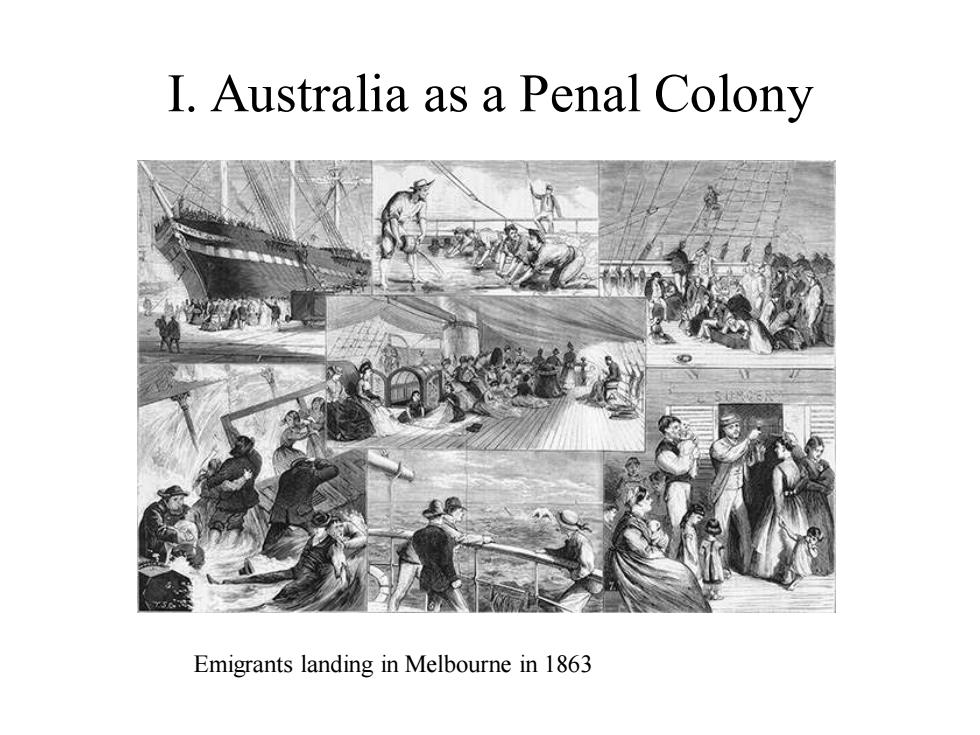
I.Australia as a Penal Colony Emigrants landing in Melbourne in 1863
I. Australia as a Penal Colony Emigrants landing in Melbourne in 1863

I.Australia as a Penal Colony The Parramatta Female Factory,in the former penal colony of New South Wales,is located in the grounds of North Parramatta,New South Wales.It was one of 13 female factories in the colonies of New South Wales and Van Diemen's Land.The factory idea was a combination of the functions of the British bridewells,prisons and The entrance to the Parramatta workhouses. Female Factory
I. Australia as a Penal Colony • The Parramatta Female Factory, in the former penal colony of New South Wales, is located in the grounds of North Parramatta, New South Wales. It was one of 13 female factories in the colonies of New South Wales and Van Diemen’s Land. The factory idea was a combination of the functions of the British bridewells, prisons and workhouses. The entrance to the Parramatta Female Factory

I.Australia as a Penal Colony Many of the women and men,who had been transported as convicts,lived together and had children without having been officially married in church.In Australian terms,these were“de facto'”families. Convict partnerships were not the only form of family of this era.There were also free"families of people who came over with the transported convicts,families of soldiers or administrators of the colony or people who arrived as "free settlers".However,the majority of men in the early years of the colony did not have wives.The majority of men,of course,were also convicts
I. Australia as a Penal Colony • Many of the women and men, who had been transported as convicts, lived together and had children without having been officially married in church. In Australian terms, these were “de facto” families. • Convict partnerships were not the only form of family of this era. There were also “free” families of people who came over with the transported convicts, families of soldiers or administrators of the colony or people who arrived as “free settlers”. However, the majority of men in the early years of the colony did not have wives. The majority of men, of course, were also convicts